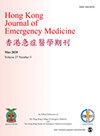Positive impact of trauma center to exsanguinating pelvic bone fracture patient survival: A Korean trauma center study
IF 0.8
4区 医学
Q4 EMERGENCY MEDICINE
引用次数: 1
Abstract
Background: Trauma center and multidisciplinary management protocols have been proven to improve the outcomes of severely injured patients. Hemorrhage from pelvic injury is associated with high mortality and is a common cause of preventable trauma death. This study aimed to evaluate the effects of the establishment of a trauma center and management protocols on the outcomes of hemodynamically unstable patients with pelvic fractures. Methods: Hemodynamically unstable patients with pelvic fractures were reviewed retrospectively over a 10-year period. They were grouped into the pre-phase and post-phase, which were defined as before and after the establishment of a trauma center and protocols, respectively. Basic characteristics and outcomes were compared between periods. Results: This study enrolled a total of 106 patients. Basic and physiological characteristics were not significantly different in both phases. Pre-peritoneal packing and resuscitative endovascular balloon occlusion of aorta were only performed in the post-phase (pre-peritoneal packing, N = 27; resuscitative endovascular balloon occlusion of aorta, N = 10). In the post-phase, the time from emergency department arrival to hemostatic intervention was significantly shorter (269 ± 132.4 min vs 147.2 ± 95.5 min, p < 0.0001), and mortality due to acute hemorrhage was significantly lower (p = 0.003; absolute risk reduction: 0.22; relative risk reduction: 0.72). Multivariate logistic regression analysis identified age, injury severity score, and the pre-phase as independent risk factors for mortality. Conclusion: The establishment of a trauma center and multidisciplinary management protocols, such as pre-peritoneal packing and resuscitative endovascular balloon occlusion of aorta, improved the outcomes of hemodynamically unstable patients with pelvic fractures.创伤中心对盆腔出血骨折患者生存的积极影响:韩国创伤中心的研究
背景:创伤中心和多学科管理方案已被证明可以改善严重受伤患者的预后。骨盆损伤出血与高死亡率有关,是可预防的创伤死亡的常见原因。本研究旨在评估创伤中心的建立和管理方案对血液动力学不稳定的骨盆骨折患者预后的影响。方法:回顾性分析10年来血液动力学不稳定的骨盆骨折患者。他们被分为前阶段和后阶段,分别定义为创伤中心和方案建立之前和之后。比较不同时期的基本特征和结果。结果:本研究共纳入106名患者。两个阶段的基本特征和生理特征没有显著差异。腹膜前填塞和主动脉的复苏性血管内球囊闭塞仅在术后阶段进行(腹膜前填塞,N = 27;复苏性血管内球囊闭塞主动脉,N = 10) 。在后期,从急诊科到达止血干预的时间明显缩短(269 ± 132.4 最小值与147.2 ± 95.5 最小值,p < 0.0001),急性出血导致的死亡率显著降低(p = 0.003;绝对风险降低:0.22;相对风险降低:0.72)。多变量逻辑回归分析确定年龄、损伤严重程度评分和前期是死亡率的独立风险因素。结论:创伤中心的建立和多学科管理方案,如腹膜前填塞和复苏性血管内球囊闭塞主动脉,改善了血液动力学不稳定的骨盆骨折患者的预后。
本文章由计算机程序翻译,如有差异,请以英文原文为准。
求助全文
约1分钟内获得全文
求助全文
来源期刊

Hong Kong Journal of Emergency Medicine
EMERGENCY MEDICINE-
CiteScore
1.50
自引率
16.70%
发文量
26
审稿时长
6-12 weeks
期刊介绍:
The Hong Kong Journal of Emergency Medicine is a peer-reviewed, open access journal which focusses on all aspects of clinical practice and emergency medicine research in the hospital and pre-hospital setting.
 求助内容:
求助内容: 应助结果提醒方式:
应助结果提醒方式:


